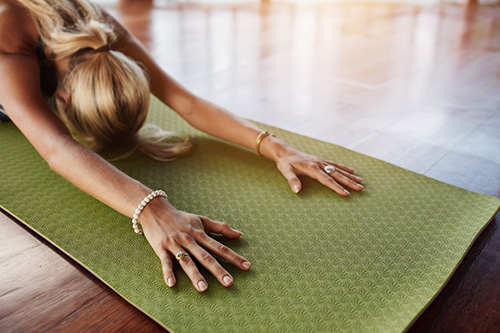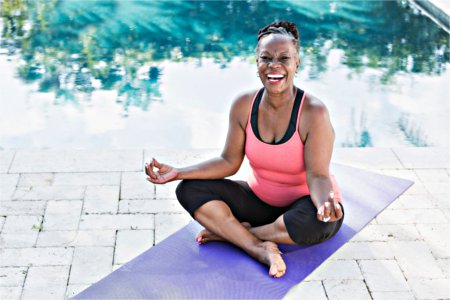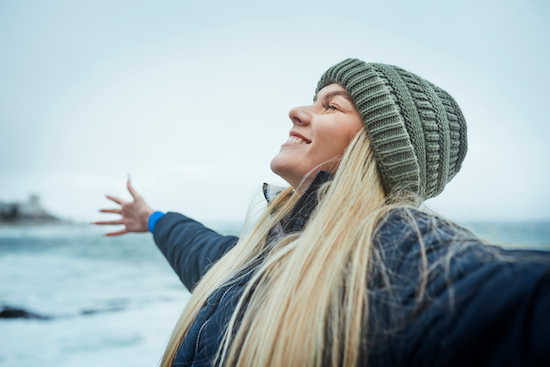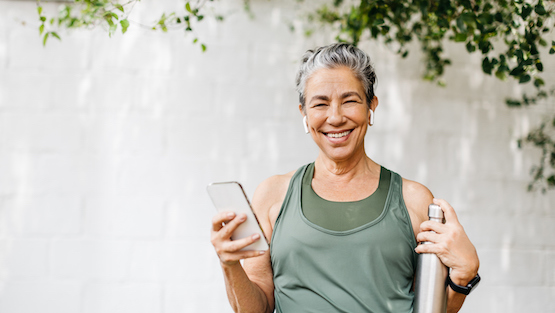I know it can feel intimidating to go to a new yoga class — let alone your very first class ever. But you know it’s going to be worth it! So let’s give you a little knowledge to drive away your worst fears. Here’s what you can expect from your first yoga class, along with tips to help you have a great experience.

Choosing your first yoga class
The barrage of options of studios, instructors and classes can be overwhelming. To choose what’s right for you as a beginner, start with a class with a name like Basics, Level 1 or Gentle Yoga. If a studio doesn’t offer beginner options, try the Open Flow or All Levels class.
If you’re considering starting above the beginner level, be honest with yourself about your ability and responsible about what class you attend. Avoid the Advanced/Hot/Upper Level classes — these may overheat, outpace or overwhelm you.
Be aware of the special approach of Restorative or Yin classes. In Restorative, you’ll use all the props to support long-held resting poses. In Yin, you’ll hold shapes and stretches for several minutes at a time. While these styles are wonderful and have many benefits, they might not be what a beginner is seeking for her first experience.
Arriving at the studio
I suggest you allow for time to arrive, fill out a waiver (a standard liability form that any wellbeing or fitness center will require) and ask about “newcomer” specials. Arriving about 15 minutes early should suffice for most studios.
Don’t be shy! Introduce yourself to the instructor and let her know it’s your first time. Express concerns, ask questions or explain any injuries you may have. She or he will appreciate your honesty and perhaps offer up some comforting tips before class begins.
Getting started
Barefoot?
Yep! Yoga is a no shoes, no socks practice. So, be ready to remove your shoes as soon as you enter the studio. Never walk into the practice space with your shoes on. Remove your socks once practice begins — otherwise your socked feet will slip around on your mat as you enter your first Downward Facing Dog.
What way does my mat go?
Observe which direction the others set up their mats. Don’t have a mat? No worries — most studios have them for rent or for free. Then, grab some props: a set of blocks, a blanket or two, a strap! You’ll learn how to use them along the way.

Consider that if you set up toward the back of the space, you’ll be able to see the room and follow along. Plus, then you won’t have to worry about people looking at you — even though, trust me, no one is… but we’ll get to that later.
Um? Om?
The instructor may chant Om to open class or to close the practice. There is no pressure to join in. If you feel hesitant, then just listen to the sound and vibration of the room. You can opt out or join in whenever you please.
Do I have to sit still?
Seated meditation may come up at the beginning or end of practice. It may feel challenging to sit quietly and in stillness. Trust that ease and benefit will eventually arrive through patience and practice. So, give it a chance.
Is she going to touch me?
Some yoga teachers give physical assists — and some don’t. An assist is not meant to single you out or make you look bad. It’s meant to bring safety and clarity to the alignment of your body within the postures. For that reason, you might eventually welcome them.
Instructors usually ask before offering hands-on adjustments. If you feel uncomfortable with this, you have every right to have a hands-off practice — yoga classes are very respectful places. So just indicate your preference when asked.
What-the-asana?
Expect to hear a bunch of words ending in “asana” — which means seat or pose in Sanskrit. For example, Uttanasana translates to Standing Forward Fold. Some instructors use one name, both or neither throughout class. Don’t be thrown off — you’ll learn the postures and their names with time. There’s no rush in yoga class, either!
So… now we just lie here?
Savasana (Corpse Pose) can confuse those who have never taken a yoga class before. At the very end, we lie on our backs and allow for our bodies to rest for a few minutes. This last posture provides for time and space to digest and assimilate from the practice we just did. At first it may feel weird, but within just a few classes, you’ll be looking forward to this much needed rest time. Embrace it.
Are they all looking at me?
While it’s natural to feel awkward or self-conscious, those feelings will subside and you’ll realize that nobody is watching you, nor do they care how you look. Everyone else is immersed in what the instructor is offering and how they embody that in their own physical form and on their own mat.
As you learn the process and postures, your concern and focus will shift to your practice alone. You’ll soon understand that the group practice is made of everyone’s combined individual practices and shifting energy, and the positivity of this throughout the course of the class.
How do I follow along?
Be prepared to develop your capacity to listen to both the instructor’s cues and your body’s feedback. If you feel unsure about what certain “alignment cues” mean, then yes, by all means, glance up to see her or the others, as a visual can help. But be careful not to rely solely on this, as she may not demo every single part of class.
Trust that if the instruction is to let your head hang down toward the floor, then do so and breathe there until the next cue. It’s not necessary to constantly pop your head up, look around every few seconds, or lock your eyes to the teacher’s each and every move.

Getting comfortable with your inner dialogue
Try to erase any internal dialogue such as “I’m bad at yoga” or “I’m inflexible therefore I can’t.” And, get rid of any competitive or comparative mentalities.
First of all, you aren’t , you just need to learn it.
Secondly, consider that if you aren’t flexible, yoga will stretch, lengthen and nourish those tight areas of your body over time.
Lastly, respect your own physical limitations. Don’t push yourself into a posture that you aren’t ready for just because someone next to you goes further. You don’t get a medal for most flexibility nor for injuring yourself — but you do gain a lot from self-awareness and self-compassion.
Practice means to try it more than once
That’s right. It’s a practice — learning and benefiting from yoga will take just that, plus patience and commitment. Even those of us who are no longer “new” to yoga are still learning and evolving every time we step onto the mat.
Have an open mind and consider that if you don’t vibe with this first class or instructor, you might find one that you resonate with next time. Try several different instructors or studios before you make up your mind about yoga. The good thing about the wealth of yoga classes and teachers out there is that there’s something for everyone.
I encourage you to remember this…
No matter how you think the class went, take a moment to acknowledge your ability, will and courage to show up to your practice. You won’t get it perfect on the first try but it’s not about impressing anyone with your “yoga skills”… it’s about caring for and developing a deeper and clearer relationship with your body and mind. And that just might change your life.
 |
Curious about beginning yoga poses? Here are 5 poses for every body with photos, explanations and benefits of each pose. |










